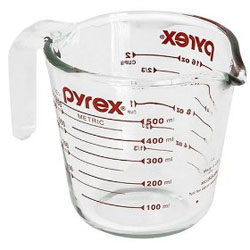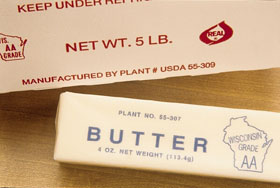
 Home-baked Christmas butter cookies are a memorable part of the holidays. Home-baked Christmas butter cookies are a memorable part of the holidays.
December 2008
|
 |
Recipes: Christmas Butter Cookies
But Delicious Year-Round
Page 1: Cookie Baking Tips
CAPSULE REPORT: Nothing says Christmas like the scent of fresh-baked cookies wafting through the house; fewer gifts are more welcome than delicious butter cookies. If you want the gift to last longer, package the cookies in a beautiful tin or cookie plate.
For the best-tasting cookies, start with the best ingredients—especially quality butter. Cookies made with real butter take have a far more delicious taste and texture (and the calories are the same as margarine). Here are some extra special cookie recipes from the Wisconsin Milk Marketing Board (WMMB) that combine traditional flavors with some unexpected ingredients, such as blue cheese and lemongrass. We think you’ll love them!
This is Page 1 of a five-page article. Click the black links below to view the other pages.
Cookie Baking Tips
Here are 10 tips to make the baking process even easier. Of course, they’ll help you out all year round:
- Get Prepped. Before you begin baking, make sure you are familiar with the recipe,
its ingredients and preparation techniques. Read the recipe thoroughly and organize the necessary ingredients and equipment in your baking area.
 Measure Up. Baking is a science; the more accurate your ingredient measurements, the better your end product. Sift or stir dry ingredients as the recipe directs, prior to measuring, and then carefully spoon into the correct sized measuring cup, leveling off with a straight edge. Measure liquids in a clear measuring cup placed on a level surface. Bend over to read the amount at eye level. Measure Up. Baking is a science; the more accurate your ingredient measurements, the better your end product. Sift or stir dry ingredients as the recipe directs, prior to measuring, and then carefully spoon into the correct sized measuring cup, leveling off with a straight edge. Measure liquids in a clear measuring cup placed on a level surface. Bend over to read the amount at eye level.- No Substitutions. Don’t use spreads, such as margarine, or shortening or part-butter products, to replace butter in a recipe. Spreads contain less fat and more water than butter and will not perform the same.
- Avoid Sticky Situations. Keep cookies from sticking to baking sheets by using a layer of parchment paper to cover the baking sheets or by buttering the sheets with a piece of buttered paper towel.
- Chill Out. For the best cookie results, keep dough chilled in between baking batches of cookies. For cutout cookies, work with only one small piece of dough at a time and keep remaining dough refrigerated.
- The Right Roll. Roll cookie dough between two layers of lightly floured parchment
or wax paper. The cookie dough will roll evenly and remove easily, without sticking
to the rolling pin or counter.
- Quick to Cool. Cookies bake best when the dough is placed on cool cookie sheets (heat causes the cookies to spread immediately and too much). Accelerate the cooling process by running tepid water over the back of your baking sheets. Dry thoroughly.
- Well-Defined Lines. For crisp-looking, well-defined holiday cookie shapes, place
cutouts on a cookie sheet and refrigerate about 30 minutes before baking.
- Perfect Timing. Watch cookies carefully during baking and remove when they begin
to turn light brown around the edges. Remember, cookies continue to bake from the heat of the cookie sheet after they are removed from the oven.
- Safe Storage. Store soft cookies, such as drop cookies, in a container with a tight lid, and crisp cookies, such as Florentines, in a container with a loose lid.
Tips For Cooking With
Butter
Don’t take butter for granted. You’ll get a better performance from your butter when you follow these guidelines:
- Keep it Fresh. Store butter in its original packaging or in a tightly covered container in the coldest part of the refrigerator, not in the refrigerator door. Keep butter away from foods with strong odors or distinct flavors.
- Freeze It If You Need To. Butter can be frozen in its original container (box
 and wrapping) for up to four months from the time
of purchase. To protect the flavor of the butter, wrap the container in aluminum foil or in an airtight plastic freezer bag before freezing. Once butter is thawed, it should be used within 30 days. Read more in THE NIBBLE’s article on Butter Storage Tips. and wrapping) for up to four months from the time
of purchase. To protect the flavor of the butter, wrap the container in aluminum foil or in an airtight plastic freezer bag before freezing. Once butter is thawed, it should be used within 30 days. Read more in THE NIBBLE’s article on Butter Storage Tips.
- Soften It For Cookies. For melt-in-your-mouth cookies, use slightly softened butter. With its low melting point, butter helps make cookies soft and chewy on the inside, but crisp and golden on the outside. When making cookie dough, don’t melt the butter soften it. This may result in dough that spreads when it’s baked, or flat, thin cookies. Instead, cut the butter into small chunks; at room temperature, it will soften in about 15 minutes.
- But Not For Pastry. For flakier pie crusts and puff pastries, keep butter as hard and cold as possible prior to use. The flaky texture is produced when cold pieces of butter, trapped between thin layers of dough, melt during baking, creating small air pockets. Don’t over-roll pie dough: The more you roll it, the tougher it gets.
- Or Sauces. Butter makes sauces smooth and creamy, and creates a cohesive consistency by helping mix both fat- and water-based ingredients. For the best consistency and flavor, use cold, hard butter. Adding butter along with savory or sweet spices helps retain the flavor of the spices and works to integrate the flavor throughout the entire dish.
- See more tips about butter and how to make sure yours tastes the best.
Ready to make cookies?
Go To Page 2: Chocolate Cookie Recipes
Return To The Article Index Above
Recipes copyright © Wisconsin Milk Marketing Board. All other materials

|





 Measure Up
Measure Up and wrapping) for up to four months from the time
of purchase. To protect the flavor of the butter, wrap the container in aluminum foil or in an airtight plastic freezer bag before freezing. Once butter is thawed, it should be used within 30 days. Read more in THE NIBBLE’s article on
and wrapping) for up to four months from the time
of purchase. To protect the flavor of the butter, wrap the container in aluminum foil or in an airtight plastic freezer bag before freezing. Once butter is thawed, it should be used within 30 days. Read more in THE NIBBLE’s article on